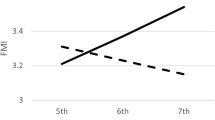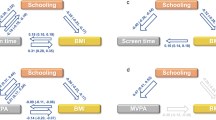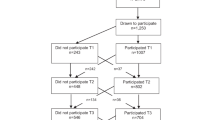Abstract
Increased sedentariness has been linked to the growing prevalence of obesity in children, but some longitudinal studies suggest that sedentariness may be a consequence rather than a cause of increased adiposity. We used Mendelian randomization to examine the causal relations between body mass index (BMI) and objectively assessed sedentary time and physical activity in 3–8 year-old children from one Finnish and two Danish cohorts [NTOTAL=679]. A genetic risk score (GRS) comprised of 15 independent genetic variants associated with childhood BMI was used as the instrumental variable to test causal effects of BMI on sedentary time, total physical activity, and moderate-to-vigorous physical activity (MVPA). In fixed effects meta-analyses, the GRS was associated with 0.05 SD/allele increase in sedentary time (P=0.019), but there was no significant association with total physical activity (beta=0.011 SD/allele, P=0.58) or MVPA (beta=0.001 SD/allele, P=0.96), adjusting for age, sex, monitor wear-time and first three genome-wide principal components. In two-stage least squares regression analyses, each genetically instrumented one unit increase in BMI z-score increased sedentary time by 0.47 SD (P=0.072). Childhood BMI may have a causal influence on sedentary time but not on total physical activity or MVPA in young children. Our results provide important insights into the regulation of movement behaviour in childhood.
This is a preview of subscription content, access via your institution
Access options
Subscribe to this journal
Receive 12 print issues and online access
$259.00 per year
only $21.58 per issue
Buy this article
- Purchase on Springer Link
- Instant access to full article PDF
Prices may be subject to local taxes which are calculated during checkout


Similar content being viewed by others
References
Prentice-Dunn H, Prentice-Dunn S . Physical activity, sedentary behavior, and childhood obesity: a review of cross-sectional studies. Psychol Health Med 2012; 17: 255–273.
Must A, Tybor D . Physical activity and sedentary behavior: a review of longitudinal studies of weight and adiposity in youth. Int J Obes 2005; 29: S84–S96.
Hjorth MF, Chaput J-P, Ritz C, Dalskov S-M, Andersen R, Astrup A et al. Fatness predicts decreased physical activity and increased sedentary time, but not vice versa: support from a longitudinal study in 8-to 11-year-old children. Int J Obes 2014; 38: 959–965.
Metcalf BS, Hosking J, Jeffery A, Voss L, Henley W, Wilkin T . Fatness leads to inactivity, but inactivity does not lead to fatness: a longitudinal study in children (EarlyBird 45). Arch Dis Childhood 2010; 96: 942–947.
Richmond RC, Smith GD, Ness AR, den Hoed M, McMahon G, Timpson NJ . Assessing causality in the association between child adiposity and physical activity levels: a Mendelian randomization analysis. PLoS Med 2014; 11: e1001618.
Speliotes EK, Willer CJ, Berndt SI, Monda KL, Thorleifsson G, Jackson AU et al. Association analyses of 249,796 individuals reveal 18 new loci associated with body mass index. Nat Genet 2010; 42: 937–948.
Franks PW, Ravussin E, Hanson RL, Harper IT, Allison DB, Knowler WC et al. Habitual physical activity in children: the role of genes and the environment. Am J Clin Nutr 2005; 82: 901–908.
Väistö J, Eloranta A-M, Viitasalo A, Tompuri T, Lintu N, Karjalainen P et al. Physical activity and sedentary behaviour in relation to cardiometabolic risk in children: cross-sectional findings from the Physical Activity and Nutrition in Children (PANIC) Study. Int J Behav Nutr Phys Act 2014; 11: 55.
Felix JF, Bradfield JP, Monnereau C, van der Valk RJ, Stergiakouli E, Chesi A et al. Genome-wide association analysis identifies three new susceptibility loci for childhood body mass index. Hum Mol Genet 2015; 25: 389–403.
Andersen LBB, Pipper CB, Trolle E, Bro R, Larnkjær A, Carlsen E et al. Maternal obesity and offspring dietary patterns at 9 months of age. Eur J Clin Nutr 2014; 69: 668–675.
Eloranta A, Lindi V, Schwab U, Kiiskinen S, Venäläinen T, Lakka H et al. Dietary factors associated with metabolic risk score in Finnish children aged 6–8 years: the PANIC study. Eur J Nutr 2014; 53: 1431–1439.
WHO WHO Anthro for Personal Computers, Version 3.2. 2, 2011: Software for Assessing Growth and Development of the World’s Children. WHO: Geneva, Switzerland, 2010.
Saari A, Sankilampi U, Hannila M-L, Kiviniemi V, Kesseli K, Dunkel L . New Finnish growth references for children and adolescents aged 0 to 20 years: length/height-for-age, weight-for-length/height, and body mass index-for-age. Ann Med 2011; 43: 235–248.
Baiocchi M, Cheng J, Small DS . Instrumental variable methods for causal inference. Stat Med 2014; 33: 2297–2340.
Bowden J, Davey Smith G, Burgess S . Mendelian randomization with invalid instruments: effect estimation and bias detection through Egger regression. Int J Epidemiol 2015; 44: 512–525.
Timmons BW, Naylor P-J, Pfeiffer KA . Physical activity for preschool children-how much and how? This article is part of a supplement entitled Advancing physical activity measurement and guidelines in Canada: a scientific review and evidence-based foundation for the future of Canadian physical activity guidelines co-published by Applied Physiology, Nutrition, and Metabolism and the Canadian Journal of Public Health. Appl Physiol Nutr Metab 2007; 32 (Suppl. 2E):S122–S134.
De Geus EJ, Bartels M, Kaprio J, Lightfoot JT, Thomis M . Genetics of regular exercise and sedentary behaviors. Twin Res Hum Genet 2014; 17: 262–271.
Hinkley T, Salmon J, Okely AD, Trost SG . Correlates of sedentary behaviours in preschool children: a review. Int J Behav Nutr Phys Act 2010; 7: 66.
Acknowledgements
We specially want to express our thanks to the participant children and their parents that were part of the SKOT I, SKOT II and PANIC studies. This project was carried out as part of the research programme ‘Governing Obesity’ funded by the University of Copenhagen Excellence Programme for Interdisciplinary Research (www.go.ku.dk) and was supported by the Danish Diabetes Academy supported by the Novo Nordisk Foundation. The SKOT studies were supported by grants from The Danish Directorate for Food, Fisheries and Agri Business as part of the ‘Complementary and young child feeding (CYCF) – impact on short- and long-term development and health’ project. The PANIC study was funded by grants from Ministry of Social Affairs and Health of Finland, Ministry of Education and Culture of Finland, Finnish Innovation Fund Sitra, Social Insurance Institution of Finland, Finnish Cultural Foundation, Juho Vainio Foundation, Foundation for Paediatric Research, Doctoral Programs in Public Health, Paavo Nurmi Foundation, Paulo Foundation, Diabetes Research Foundation, Yrjö Jahnsson Foundation, Finnish Foundation for Cardiovascular Research, Research Committee of the Kuopio University Hospital Catchment Area (State Research Funding), Kuopio University Hospital (previous state research funding (EVO), funding number 5031343), and the city of Kuopio. The Novo Nordisk Foundation Center for Basic Metabolic Research is an independent research center at the University of Copenhagen partially funded by an unrestricted donation from the Novo Nordisk Foundation (http://metabol.ku.dk). The work of Soren Brage was funded by the UK Medical Research Council [MC_UU_12015/3]. Tuomas O Kilpeläinen was supported by the Danish Council for Independent Research (DFF – 1333-00124 and Sapere Aude program grant DFF – 1331-00730B).
Author information
Authors and Affiliations
Corresponding author
Ethics declarations
Competing interests
The authors declare no conflict of interest.
Additional information
Supplementary Information accompanies this paper on International Journal of Obesity website
Supplementary information
Rights and permissions
About this article
Cite this article
Schnurr, T., Viitasalo, A., Eloranta, AM. et al. Genetic predisposition to adiposity is associated with increased objectively assessed sedentary time in young children. Int J Obes 42, 111–114 (2018). https://doi.org/10.1038/ijo.2017.235
Received:
Revised:
Accepted:
Published:
Issue Date:
DOI: https://doi.org/10.1038/ijo.2017.235
This article is cited by
-
Distilling causality between physical activity traits and obesity via Mendelian randomization
Communications Medicine (2023)
-
Vitamin D status of 3-year-old children in Denmark: determinants and associations with bone mineralisation and blood lipids
European Journal of Nutrition (2023)
-
What is the role of cardiorespiratory fitness and sedentary behavior in relationship between the genetic predisposition to obesity and cardiometabolic risk score?
BMC Cardiovascular Disorders (2022)



